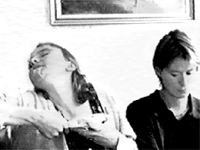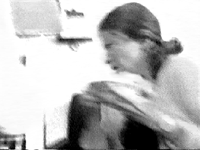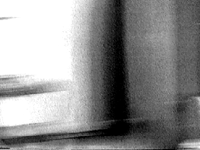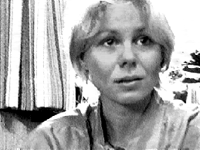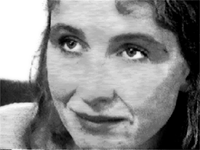|
In his existential writings on Christianity, Concluding Unscientific Postscript to Philosophical Fragments, Kierkegaard, masked as Johannes Climacus, discusses among other things "the pathetic."[1] In conclusion to section two he writes: "We one-sidedly say that a fool always laughs, one-sidedly, because it is true that it is foolishness always to laugh; but it is one-sided to label only the misuse of laughter as foolishness, since foolishness is just as great and just as corruptive when it expresses itself by always being equally earnest-obtuse." (Hong I, 525). That a religious explanation for the relationship between an esthetic philosophy of life (based on the relation happiness-unhappiness) and a religious one (based on suffering) leads to praising the foolís laughter[2] is due to the fact that Climacus is described as a non-Christian humorist, who in the 19th century lacks religious pathos. Climacus dwells on humor when describing the existential conditions of the pathetic in its difference from esthetic pathos, since "The esthetic and the ethical have been mixed together in comfortable balderdash." (Hong I, 392). The difference between "the pathetic" and "the esthetic" concerns the subject or "inwardness," as Kierkegaard also calls it.
Another possible distinction involves the possible as opposed to the actual: "In relation to possibility, words are the highest pathos; in relation to actuality, actions are the highest pathos" (Hong I, 389-90), which is why falling in love belongs to the field of esthetics and marriage to that of ethics. With these few definitions it is easy to see that the pathos that flourishes in Lars von Trierís works Breaking the Waves (1996) and The Idiots (1998) is ethically rather than esthetically based. Bessís choice is ethical-religious, and her decisive act (the self-sacrifice) confirms her pact with (her internalized) God and her marriage pact. The sacrifice is a conscious act that radically leaves behind the Church congregationís esthetic ideal (and love of the word rather than of people). Bess abandons a relation to being and relates exclusively to becoming, to the difference her act can make. This is why the psychologist at the end of the film characterizes her as "good" (rather than "crazy"), in keeping with Climacus:
Becoming does not only contain the act of sacrifice, in which the flesh is marked. The suffering lies just as much in everyday lifeís unfinished confrontation with the existential condition of incidental trivialities that shape us. The religiously responsible subject has lost "the relativity of immediacy, its diversion, its whiling away of time – precisely its whiling away of time" and suffers in an absolute relation to God, conscious that "[a] human being is capable of nothing at all; this he must always keep in mind." (Hong I, 486). Just what possibilities does the religious person have in life when esthetics and sense diversions are abandoned? He cannot go to a monastery, as this choice is merely an outer (misunderstood) display of the relationship with God. But can he then go to the amusement park? – This is Climacusí rhetorical counter-question. The answer is at first negative, but then he argues that mankind is after all different from God and shows his humility by being human, removing himself from the absolute requirement and seeking diversion:
The discussion of the status of the amusement park is lengthy in Climacus, since its function is to create an opening for humor in ethical and religious pathos. For according to Climacus, "[t]here are three existence-spheres: the esthetic, the ethical, the religious. To these there is a respectively corresponding confinium [border territory]: irony is the confinium between the esthetic and the ethical; humor is the confinium between the ethical and the religious." (Kierkegaard underlines, Hong I, 501-2). Humor marks the incongruence between the religious personís (hidden) relationship with God and what occurs in the world, that is, between a consciousness of the infiniteness of everything and the finiteness of everything. A divine as opposed to a human perspective.[3]Thus, Climacus concludes section two with the introductory passage that starts as follows: "Therefore, it is just as questionable, precisely just as questionable, to be pathos-filled and earnest in the wrong place as it is to laugh in the wrong place. (Hong I, 525) – and thus we have returned to the beginning of this article and can now turn to The Idiots.
Karen thus freely demonstrates that Andersí (Hans Henrik Clemensen's) opinion – that it was because she "was not too sad" that she refrained from going to the funeral – is farfetched. On the contrary, Karen was in a state of shock over the death of her child, and couldn't bear to share her grief with others. She is an idiot in this wordís etymological (Greek) definition: a private person. She is an idiot in the sympathetic definition: a retarded person whose emotional development corresponds to a four-year-oldís (according to Trierís notes on her character). In contrast to the other jokesters, who act out their inner idiot as an (esthetically and ethically confrontational) idea, Karen is a true idiot who is unable to pretend. Something else is at stake. The possibility of showing her inner state at the coffee table as idiocy on the level of a child gives Karen the possibility of expressing that she not only has scars on her soul, but also marks in her flesh. Neither in The Idiots, nor in Trierís manuscript, nor in the accompanying journal, let alone in Jesper Jargilís De ydmygede, which depicts the working process of The Idiots in the form of a documentary, is there reason to believe that Lars von Trier should have read Johannes Climacusí reflections on the extent to which the religious person in the 19th century ought to choose the way to the monastery or the way to the amusement park. Nor does it matter. Just as it is inconsequential for us to know whether Kierkegaard ever set foot in the amusement park Dyrehaven.[4] It is probable that Kierkegaardís interest in this amusement park is due to the fact that it was a favorite romantic theme for describing popular entertainment, while in Trierís time the park practically marks the romantic theme as a cliché-filled framework for expensive entertainment. It is nonetheless noteworthy that the common interest in avoiding an esthetic judgement of an ethical manifesto[5] very effectively uses Dyrehaven as the background for describing "true pathos." For this must necessarily be sensed. In Kierkegaardís text, the opposition of Dyrehaven and the religious requirement seems like a slap in the face. In Trier, it must be added as a realistic shock that also stylistically breaks with the layout of the living room. The violence of the sudden movement depicted with the shaking of the hand-held camera comes to concern the viewer directly – as though it were her/him whose vision took a blow.
Moreover, if one recalls that Kierkegaardís volume 10 cited above provided the basic concepts for French existentialism after the war, the association becomes even more evident, leading to the idea that the dogma films, and perhaps The Idiots in particular, can in agreement with the dogma manifesto actually be regarded as a continuation of the confrontation with plot-structured descriptions of reality that were represented by the nouvelle vague (from the late 1950s).[6] It is true that today, regardless of great differences, directors like Godard, Truffaut, Chabrol and Resnais, who took André Bazinís praise of the break with the tradition of mimesis as their starting point to experiment with the possibilities of the cinema (and developed the concept of the auteur), seem more romantic-individualistic than revolutionary – as it is put in the dogma manifesto. Still, it is easy to see that the directors who take into account the nouvelle vague and the dogma manifesto agree on wishing to describe something essential in the special cinematic coming into being of something "true" or something "real." To the sympathetic, confused viewer, The Idiots poses fundamental questions about what sets our esthetic criteria for evaluation – as do many of Godardís works. They share enthusiasm and stylistic courage. But The Idiots inquires perhaps outside an esthetic framework rather than inside, and it is in this sense that one can claim that Trier is more courageous or more revolutionary than Godard. It is also suggestive that Trier dons just as many masks as Kierkegaard in order to penetrate with a statement about life with a pathetic (ethical and religious) stamp.[7] For throughout the century, not just religious but also esthetic pathos has been surrounded with disdain in the name of high-modernism,[8] even though everyone no doubt can see today that it has been alive and well and visible and hearable to everyone, both within the ranks of modernism (in the cultivation of the genius and the avant-garde) and in popular culture (especially in the cinematic melodramaís and rock cultureís appeal to their audiences). Perhaps it was (as regards the film medium) the 1980sí ironic blend of genres, erosion of values and labyrinthine strategy that cleared the way for a non-Cartesian understanding of the subject as an impassioned unity of body and mind. Trierís own works, Breaking the Waves, whose melodramatic framework faded away and was transformed into ethical or subliminal pathos,[9] and Kingdom II, which has given new meaning to the designation of "the grotesque," has consistently shifted the focus away from a re-presentation of the real. In the 1990s, Trier left behind the poetic pathos "the pathos of possibility, with actuality [virkeligheden] as an occasion", now more "maturely" posing himself (as does Climacus) the question of "oneīs own ethical actuality as infinitely more important than the interpretation of the whole world history (Hong I, 389)[10]. In Kingdom II it was the spiritual beings (without temporal or spatial mooring) and the Swedenborgian space that challenged the idea of a bodily and personal delimitation, while in The Idiots it is the Steinerian idea that people with Down's syndrome are like angels sent as a present to mankind. (Cp. Trierís description of the filmís conceptual starting point in De ydmygede). It is far from my task here to advocate that Trier and others along with him should really be understood religiously, much less that Kierkegaard should be. It is far more important for me to point out that currently Danish (and international) artists are (with or without inspiration from Kierkegaardís concepts of pathos) actually confronting "actuality as an occasion" or "the pathos of possibility" with a radically different "ethical actuality" (op. cit.). This reality concerns the subjectís (i.e. the artistís) entire way of sensing and experiencing when confronting the world. The work becomes an expression of this confrontation and thus must also influence the viewer. Elements of horror and abject traces in an apparently realistic scenario have long been visible in art (cp. David Lynch, among others)[11]. Today the very idea of artistic re-presentation is being discussed. After the deconstructive and meta-fictional pointing out of esthetic-rhetorical patterns in each work, it is understandable that the interest is now directed toward that which conditions or lies outside esthetic representation[12]. This is why ethical questions become relevant in a digital world that otherwise makes each and every simulacrum possible. What a splendid liberation from the world, what unsuspected possibilities of esthetic manipulation, one might say! And yet at least one European tradition recedes. Like much current fine art photography, the dogma concept reflects what an artistic becoming or event might be without a referential base. And here humor and the "becoming mad" of esoteric language also plays a main role according to Gilles Deleuze:
In Trier, the idiot plays the role of the fourth person singular – and what is more: this role is also meant for the viewer, as is also evident from several reviews[14]. Ingeniously, one can (along with Climacus) very well regard Trier as being a "straying esthete" (Hong I, 454) in the field of ethics, one who does not experience pain or uncertainty, but who is more precisely an "esthetic coxcomb, a devil of a fellow who, figuratively speaking, wants to fraternize with God but, strictly speaking, does not relate himself to God at all" (Hong I, 455). But if one regards works of art as events rather than as representations, or as an interplay between fabula and sjuzet, the surface humor that takes the power away from meanings can actually (150 years after Climacus) give insight into "their eternal truth, that is, from the point of view of the substance which sub-tends them, independent of their spatio-temporal actualization in a state of affairs" (Deleuze, op. cit., 136). There are many examples of this strategy in The Idiots, and not everyone finds them equally funny. The confrontations between the self-appointed idiots and the sympathetic rockers call forth more laughter in me than the confrontations between the citizens and municipal officers of Søllerød County. Stoffer (Jens Albinus), who exposes the latter, depicts (intentionally on Trierís part) psychological instability rather than foolishness, and for this reason one never completely surrenders to his interpretations. In the scene with the home buyers, Jeppe (Nikolaj Lie Kaas) makes a marginal remark (outside the manuscript) that together with the excellent facial mimicry of all the fools makes the idiocy perspective clear. Jeppe says impulsively, almost wonderingly, to the elegant lady (Paprika Steen): "Where zayn? Where zayn?" She replies as though it were a question: "The Seine – The Seineīs in Paris. Nice meeting youÖ" and laughs self-consciously, nervously and shyly at the same time while leaving. It is impossible to tell whether Jeppeís remark is profound or meaningless[15]. The same suggestion of a possible meaning that becomes absurd in its singularity is also present in the imagery. Not so much in the outright vulgarities at the level of the jokes (mayonnaise instead of sun lotion or skiing in the summer), but rather in movements that only sporadically make sense (three naked men running after half-naked Susanne, filmed as though they were children). The Idiots is a film that challenges moral and esthetic judgements and that in a display of all kinds of judgements in this field sets the stage for another agenda, the ethical-religious one. The battle lines are drawn up with a humor that is far from being as "earnest-obtuse" as the smart-alecky poster text on Axelís (Knud Romer Jørgensen) advertising agency: "He wants to make companies into religions." Trier does not want to make film into religion, nor plead for a religiousness in the film, but most likely he would like to get us to "laugh with the fool."
| |||||||||||||||||||||
